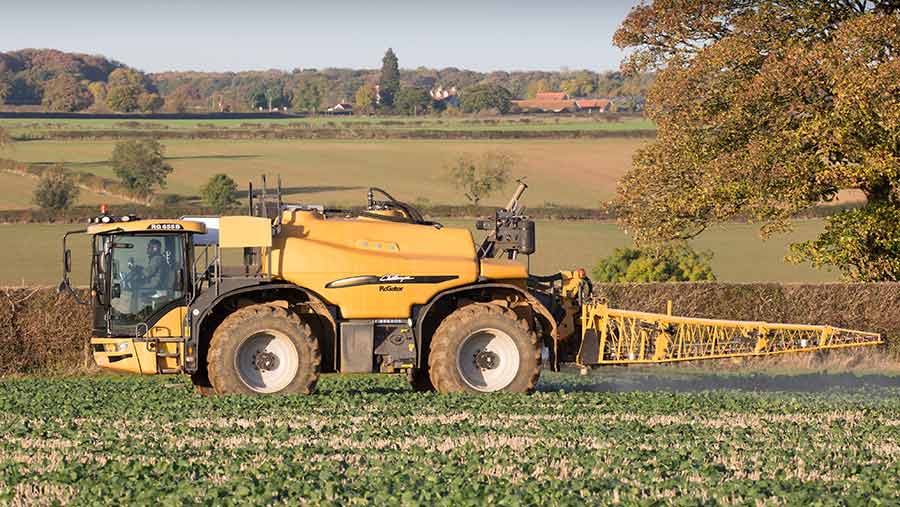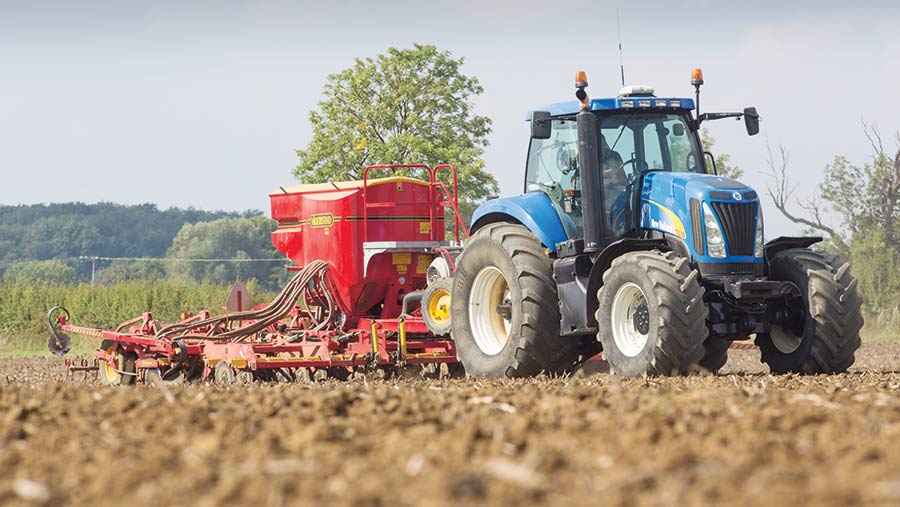Crop Watch: Rising OSR disease and aphid risk
 © Tim Scrivener
© Tim Scrivener Recent rain has come as a welcome relief for many arable farmers, with crops drilled into relatively dry seed-beds. However, it means there is likely to be a blackgrass flush in October-drilled crops.
Higher-than-average aphid numbers are also concerning agronomists, increasing the risk of barley yellow dwarf virus in cereals drilled without a neonic seed dressing.
Finally, in oilseed rape, thoughts turn to autumn fungicide strategy to manage phoma and light leaf spot this winter, with some crops in the South approaching the phoma spray threshold.
See also: Tips on managing BYDV in cereals without neonic seed treatments

Antony Wade
West: Antony Wade
Hillhampton Technical Services (Heref/Shrops)
We have generally escaped the flea beetle onslaught, but a warm weekend in the second week of September suddenly saw them descend onto many crops that were just emerging – so at the critical risk stage.
I had many phone calls saying: “They looked OK on Friday, but since the weekend it’s disappearing.”
This meant many crops got a pyrethroid spray and I’m not sure if they have been that effective, as the damage has been sustained. It was not helped by the slow growth due to a lack of moisture.
I have resisted the temptation to spray more than once with sprays that are very imprecise with their targeting and efficacy.
Clearfield varieties for me have generally seemed to have had more vigour and got away from the flea beetle quicker. Most of these have received their herbicides recently with excellent response so far.
On grassweed-free fields, drilling started in early September into good seed-beds. These have emerged well and slug damage has been minor with only the odd farm/field needing slug pelleting.
Ferric phosphate is now generally the default choice of product for most of my clients, as we have so many ditches/water courses around fields and it makes logistics much simpler for spreading.
Residual herbicides
Most of these have had pre-emergence or early post-emergence herbicides, which we hope are going to have good efficacy.
Where grassweeds are more of an issue, these have gone into good seed-beds in the past seven to 10 days, along with barley and oats in early October. Even most wheat going in after maize has been planted.
All barley crops are being targeted with an autumn residual herbicide, as we have little option for post-emergence contact grassweed control.
They will have to receive an aphicide, so T-Sum calculators are being used to target the first at about the 170dd mark.
The loss of flupyrsulfuron active is a loss to the oat crop, although I did manage to get some on to most farms with oats, so we have it to use up this autumn.
However, I am relaxed about using flufenacet under an extension of authorisation for minor use on oats, as we have been doing this on some client farms for a number of years for better grassweed control without any adverse effects on the crop.
But you have to be organised, as it is best to go on within 48 hours of drilling. While it may thin the crop with reduced oat tillering capacity, this can be easily compensated for in the spring.

Marion Self
East: Marion Self
Prime Agriculture (Suffolk)
Drilling in the East has progressed steadily as growers have moved from fields with a low blackgrass risk to those with higher populations.
As the weather becomes more changeable, this is a critical time to hold your nerve.
If you need encouragement to hold off, consider that after the recent showers, blackgrass is chitting and there is likely to be a strong flush in mid-October-drilled crops.
On fields with a history of high blackgrass populations, stay committed to spring cropping.
Despite the dry conditions, pre-emergence applications have been kept close to the drill to catch emerging blackgrass.
Seed-bed conditions are very good (fine and friable) and with moisture, the residual chemistry will become more effective.
There are some emerging cereals with blackgrass populations. At early post-emergence, it may be possible to treat these with an appropriate additional residual.
In some situations in wheat, a well-timed contact sulphonyl urea application partnered with a residual such as flufenacet or prosulfocarb may be worthwhile.
In moist soils, slug activity should be monitored more proactively. Identify areas requiring treatment, as patch treatment may be adequate.
As conditions become cooler and wetter, ferric phosphate-based pellets will be the better choice, as they have more activity and is safer for the environment than those based on metaldehyde.

© Tim Scrivener
Aphid invasion
The AHDB’s Aphid News reports that the number of barley yellow dwarf virus vectors (BYDV) – primarily the bird cherry-oat aphid – are high this season compared with the 10-year mean.
Deter (clothianidin)-treated seed will protect crops from BYDV infection for about six to eight weeks after emergence.
Where Deter has not been used, these crops require protection at the two-leaf stage.
If emergence within the field is patchy, don’t leave the early-emerged portion of crop exposed to infection while waiting for the slower/drier areas to emerge.
A swift follow-up treatment may be required to protect both ends of the emergence spectrum.
Many oilseed rape crops have already received “additional” early grassweed control, as blackgrass has flushed with vengeance in this early-established crop. Blackgrass control strategies will continue with carbetamide and propyzamide.
OSR is now receiving an early phoma treatment, as products give stronger protectant activity. Some crops will receive a split autumn fungicide treatment with a follow-up treatment tank-mixed with the propyzamide.

Mary Munro
North: Mary Munro
AICC/Strutt & Parker (Perthshire)
We have had an ideal spell of sowing weather – warm and dry with enough soil moisture to assist germination.
Autumn cereals have come through quickly and spraying is up to date, for the most part.
Wheat, barley and oat crops are looking good, and there are surprisingly few aphids about.
There are more first wheats that were sown in August than usual, and a close inspection is needed before definitely deciding not to spray an aphicide.
The good conditions have been too tempting for many growers and most of the second wheats are also sown and through the ground, potentially increasing the risk of take-all later on.
Potato harvest is moving along steadily and there may yet be more wheat drilled behind potatoes.
Winter oilseed rape has had little to stop its progress as slugs have been less of a problem than usual, and we have not suffered the damage from cabbage stem flea beetle that has been witnessed south of the border.
Cereal volunteers
There are perhaps more cereal volunteers than I would like to see in some crops, but those that have been sprayed are dying off.
It is not quite cold enough for Kerb (propyzamide) products yet – ideally the soil should be 10C and falling, while up to now it has been positively balmy.
Light leaf spot control is the next debatable point, and whether to go twice in the spring rather than once now and once in the spring. Fortunately, we do not see a lot of phoma, so can continue to focus on light leaf spot.
However, the choice of effective product is limited and it is worth keeping the application rate up.
It is easy to decide against spraying when the weather is dry, but after a couple of wet, stormy days, I suspect there may be some growers who decide they would prefer to get something on before the end of the year.
The trouble with omitting the spray now is that the ideal first timing would then be February, often when conditions are appalling.

Richard Harding
South: Richard Harding
Procam (Sussex)
Some very useful rain has fallen over the Downs this weekend, which will greatly aid residual herbicide efficacy applied to what are without doubt excellent seed-beds.
Soil temperatures are slowly beginning to cool, but are still about 12-13C at 30cm.
With much glyphosate now being used in stale seed-beds and stubbles, it is very important to be vigilant for the first signs of glyphosate resistance.
Some reduced sensitivity has already been identified in brome populations. As such it is important to maintain the correct glyphosate dose rate.
For small flushes of blackgrass, the aim should be for a minimum of 540g/ha. For a typical stubble/stale seed-bed application, the dose should not be less than 720g/ha.
The continued high air temperatures mean bird cherry-oat aphids have shown a big increase in numbers and are above the 10-year mean in the south of England, which will have implications for early-sown and emerging cereals. Numbers of Myzus persicae are also on the rise.
Attention to detail will be vital for barley yellow dwarf virus control this autumn and the AHDB’s T-Sum calculations will help to determine the optimum spray dates when secondary aphid spread is about to occur.
Other key considerations to minimise disease transmission will be leaving a four- to six-week gap between ploughing grass or weedy stubbles and drilling, where green bridge transmission is likely or to switch to using a rapid-acting desiccant.
Oilseed rape
Oilseed rape crops on the whole look excellent and continue to grow apace, with later-drilled crops now shrugging off any remaining flea beetle and slug pressure.
Reasonable levels of phoma are now starting to appear. Some crops are already at the threshold of 10% infected plants for varieties with a low resistance rating, while 20% infection can be tolerated in varieties with higher scores.
Where thresholds have been met, this is prompting an application of either straight difenoconazole on less-developed crops or prothioconazole and tebuconazole where some canopy manipulation is required.
The option then remains to come back later in the autumn to top up phoma control and cover light leaf spot overwinter at the conventional propyzamide timings, likely to be towards the middle/end of November.

